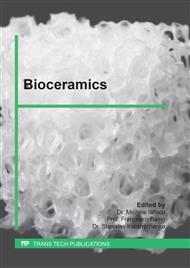p.32
p.41
p.47
p.53
p.59
p.65
p.71
p.77
p.83
Effect of Heat Treatment on Mechanical and Setting Properties of TTCP-Based Calcium Phosphate Cement
Abstract:
The objective of this study was to investigate the effect of heat treatment on setting reaction and mechanical properties of tetracalcium phosphate (TTCP) and dicalcium phosphase (DCP)-based calcium phosphate cements. CPC pastes were prepared at room temperature and heated at different temperatures (from 37 to 60°C) for 10 min. Then, the preheated CPC pastes were rapidly cooled down to room temperature before further heated at 37°C until they set. Three different CPC formulations prepared from different particle sizes of TTCPs were used for the investigation. From the study, it was found that preheating could accelerate setting reaction for all CPCs according to increasing speed of hydroxyapatite (HA) conversion. The higher the preheating temperature, the faster the cements could set. However, at preheating temperature higher than 60°C longer cement setting times were observed. It may be that at high temperature some liquid content in the CPC paste evaporated, resulting in slow setting reaction rate. Compressive strengths of the cements after immersion in simulated body fluid (SBF) for 7 days increased as a result of an increase of HA conversion.
Info:
Periodical:
Pages:
59-64
Citation:
Online since:
April 2019
Keywords:
Price:
Сopyright:
© 2019 Trans Tech Publications Ltd. All Rights Reserved
Share:
Citation:



